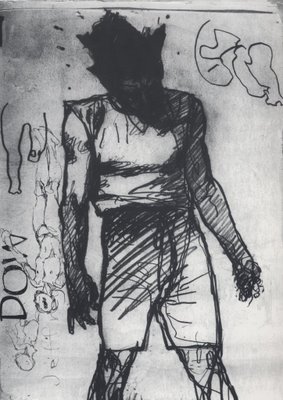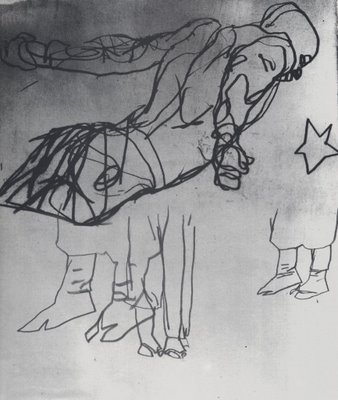I like it.
Sunday, April 29, 2007
Looking through canvas. Małgorzata Ata Warias
I like it.
Saturday, April 28, 2007
THE LATEST NEWS FROM THE DISTANT PAST
Holland Carter once wrote, "I go to museums to get the latest news from the distant past."
There's no better place to look for news than in the changing depictions of the human form. Artists have been drawing the human body for over 20,000 years and while the body has remained the same, the drawings keep changing.
Every pose, angle, and facial expression has been drawn a thousand times by talented artists. Look at these figure drawings by the great Annibale Carracci in the 16th century:



Who would have the nerve to continue drawing the figure after Carracci if there was no new information to convey? What could another drawing possibly contribute?
The fact is, while the human form remains unchanged, each era presents fresh questions for the artist. And even when the question remains the same, the answers continue to change. Look at all the news in this wonderful drawing by Aubrey Beardsley.

Or contrast Carracci's drawings with these recent images by the talented Phil Hale:



The muscles, bones, arms and legs are the same-- and yet what a difference!

If our bodies were merely machines, they would not be a source of infinite fascination for artists. As it is, artists keep returning to the human form for fresh news about our humanity.
There's no better place to look for news than in the changing depictions of the human form. Artists have been drawing the human body for over 20,000 years and while the body has remained the same, the drawings keep changing.
Every pose, angle, and facial expression has been drawn a thousand times by talented artists. Look at these figure drawings by the great Annibale Carracci in the 16th century:



Who would have the nerve to continue drawing the figure after Carracci if there was no new information to convey? What could another drawing possibly contribute?
The fact is, while the human form remains unchanged, each era presents fresh questions for the artist. And even when the question remains the same, the answers continue to change. Look at all the news in this wonderful drawing by Aubrey Beardsley.

Or contrast Carracci's drawings with these recent images by the talented Phil Hale:



The muscles, bones, arms and legs are the same-- and yet what a difference!

If our bodies were merely machines, they would not be a source of infinite fascination for artists. As it is, artists keep returning to the human form for fresh news about our humanity.
Sticks
Contemporary art could be described as the look-out for presence. There are very pragmatic ways in which presence can be experienced. If anything can be art when given the right focus, we need to look for ways of better focusing. So when we get it, we get it. Thus, it is a constant game between what we know and what we think we might have known, had it been a slightly different setting. Darren Harvey-Regan is a beautiful example of finding what is already there, of creating what had already been there and just giving it that delicate push which makes us grow our of here and into the work.
And if you think you know exactly what it is, it might just mean you need to look more carefully, and take the time to see the landscape he has found.
Friday, April 27, 2007
Cowscapes by Rachael Sudlow
Technorati: photography, land art, art, contemporary art, vvoi
Thursday, April 26, 2007
Simply enjoying design
There is a pleasure in the usable object that is simply magical. This glovy feeling - it fits like a glove, and it feels like a glove, and it can be the most exquisite thing. Some sort of harmony, I guess. As if design gave us the world as we had imagined it ought to be, though only now does it live up to expectations. Artsy art rarely seems to head that way. (If we insist on distinguishing the two).
Technorati: design, interior design, furniture, art, contemporary art, vvoi
Tuesday, April 24, 2007
Pretty science
And now for something completely unrelated.
Technorati: science, beauty, visual art, art, contemporary art, vvoi
Rent a Wife
What the hell is going on?
Wives for rent? For an unlimited time? Chose your preferred category?
Of course, Rent-a-Wife is a joke. But is it an artistic joke? A provocation joke? A silly joke? A horribly sexist joke? Or is it?
If it is an ironic look at the way women are seen by today's society (not only male), than why does it seem strange?
Because there is a catch. (Duhh...) And it is not about feminism. It is about renting DVDs. As what we have here is an ad for DVD rental.
How far is this from Vanessa Beecroft installing her objectified women in a shoe-shelf, to sell shoes?
Could I be accused of the same hypocrisy, exposing something by exposing it?
Oh, and if you think it's getting pretty much impossible to look at gender issues in a witty way without being accused of this or that, the desert is for you:
Technorati: commercial, publicity, funny, parody, art, art, contemporary art, vvoi
Thickening light: Emilia Bergmark - Jiménez
There is a melancholy light in Emilia Bergmark-Jiménez's work that makes one want to stay there.
By «there», I don't mean the place that is being photographed, but rather, the space of the photography itself. The picture seems not so much to portray something, but rather, to use it for its own means, as if the image had a goal of its own, quite separate from the object matter, or even the photographer herself.
What is left of the person? What form can a person have if light goes through her and plays with her seeming irrelevance? Maybe, the person becomes distant. Translucent.
This may well be what remains of memory, when what is left to oblivion, is rescued by thickening the nearly empty space, the traces gaining contours that are not what was left behind, but are some ambiguous form we vaguely recognize as ours, as belonging to us, as representing this left-over area that is neither the object we knew, or the eye of the beholder. It is this lovely, strange in-between.
| | ||||||
| | | |||||
| | | |||||
Sunday, April 22, 2007
Friday, April 20, 2007
BINARY CHOICES
All the magic of the internet-- the movies, music, youtube animation, color pictures-- comes to you through a series of simple binary choices. Your computer has only two digits (0 or 1) to choose between in processing all that information. The electronic signal is either off (represented by a zero), or on (represented by a one).
Similarly, a line drawing is just a series of binary choices: it is either black or white.

Unlike a painting, which presents a rich variety of layered choices and half-choices, a drawing is a commitment: either line or not line. Look at the bold, black-or-white choices in this stunning set of illustrations by the great Harold Von Schmidt in 1929 for Death Comes For The Archbishop:


The following full page illustration demonstrates the same kind of restraint and care that abstract expressionist Barnett Newman used in selecting the perfect location for a zen stripe on a huge blank canvas.

I admit that I prefer drawings to paintings, sculpture, movies or other art forms. Through a series of binary decisions, an artist can evoke the most extraordinary effects.

These are strong, wonderful drawings worth revisiting by any fan of illustration.
Similarly, a line drawing is just a series of binary choices: it is either black or white.

Unlike a painting, which presents a rich variety of layered choices and half-choices, a drawing is a commitment: either line or not line. Look at the bold, black-or-white choices in this stunning set of illustrations by the great Harold Von Schmidt in 1929 for Death Comes For The Archbishop:


The following full page illustration demonstrates the same kind of restraint and care that abstract expressionist Barnett Newman used in selecting the perfect location for a zen stripe on a huge blank canvas.

I admit that I prefer drawings to paintings, sculpture, movies or other art forms. Through a series of binary decisions, an artist can evoke the most extraordinary effects.

These are strong, wonderful drawings worth revisiting by any fan of illustration.
Tuesday, April 17, 2007
Mancubus
 redesigned
redesignedraw OC playback vid at: http://www.youtube.com/watch?v=LEVjdbHcuww
finalized in Photoshop as usual
Thursday, April 12, 2007
ART THAT IS "SUI GENERIS" (part 1)

Every once in a great while, an artist creates an image that is sui generis-- one of a kind. You look, you tilt your head sideways and squint, you try to fit it into some existing category, but you're still not exactly sure how to react.
For me, Ivan Albright's painting "the door" (official title: "That which I should Have Done I Did Not Do") is such a painting.

Its dark, brooding subject and its melodramatic title are hardly unique. However, Albright worked on this painting for ten years. It towers over eight feet tall, and it has a level of detail that is, to say the least, psychologically troubling. Albright sometimes painted with a brush he made from one lateral spine taken from a single chicken feather. You are looking at a ten year obsession with mortality and the weight of the road not taken. This is one freaky painting.

Normally a viewer might look at a picture and ask, "Does this composition work? Do I like the color? Is it successful compared to similar pictures?" Such questions don't begin to digest such an epic statement.
Albright was not well known, but he was one of Jean Dubuffet's favorite artists. Curiously, Dubuffet had the opposite style-- he specialized in spontaneous, impulsive scribbles-- but he was stunned by Albright's door, writing "all the notions on which we have until now based our standards of appreciation of all things are erroneous."

If you are ever in Chicago, I urge you to go see this wonderful painting on display at the Art Institute.
.
Subscribe to:
Comments (Atom)



